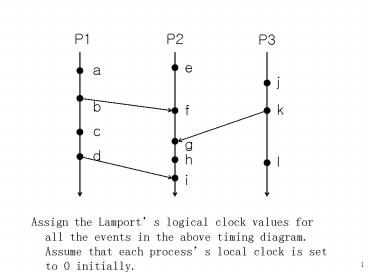Assign the Lamport PowerPoint PPT Presentation
Title: Assign the Lamport
1
- Assign the Lamports logical clock values for all
the events in the above timing diagram. Assume
that each processs local clock is set to 0
initially.
2
- From the above timing diagram, what can you say
about the following events? - between a and b a ? b
- between b and f b ? f
- between e and k concurrent
- between c and h concurrent
- between k and h k ? h
3
- Fidges Logical Clocks
- with Lamports clocks, one cannot directly
compare the timestamps of two events to determine
their precedence relationship - - if C(a) lt C(b) then a ? b
- - if C(a) lt C(b), it could be a ? b or a ? b
- - e.g, events e and b in Figure previous page
- C(e) 1 and C(b) 2
- thus C(e) lt C(b) but e ? b
- the main problem is that a simple integer clock
can not order both events within a process and
events in different processes - C. Fidge developed an algorithm that overcomes
this problem - Fidges clock is represented as a vector c1 , c
2 , , cn with an integer clock value for each
process (ci contains the clock value of process
i).
/
/
/
/
4
- Fidges Algorithm
- The Fidges logical clock is maintained as
follows - FLC1 Initially all clock values are set to the
smallest value. - FLC2 The local clock value is incremented at
least once before each primitive event in a
process. - FLC3 The current value of the entire logical
clock vector is delivered to the receiver for
every outgoing message. - FLC4 Values in the timestamp vectors are never
decremented. - FLC5 Upon receiving a message, the receiver sets
the value of each entry in its local timestamp
vector to the maximum of the two corresponding
values in the local vector and in the remote
vector received. The element corresponding to the
sender is a special case it is set to one
greater than the value received, but only if the
local value is not greater than that received.
5
- Get r_vector from the received msg sent by
process q - if l_vector q ? r_vectorq then
- l_vectorq r_vectorq 1
- for i 1 to n do
- l_vectori max(l_vectori, r_vectori)
- Timestamps attached to the events are compared as
follows - ep ? fq iff Tep p lt Tfq p
- (where ep represents an event e occurring in
process p, Tep represents the timestamp vector of
the event ep , and the ith element of Tep is
denoted by Tep i.) - This means event ep happened before event fq if
and only if process q received a direct or
indirect message from p and that message was sent
after ep had occurred. If ep and fq are in the
same process (i,e., p q), the local elements of
their timestamps represent their occurrences in
the process.
6
- Assign the Lamports and Fidges logical clock
values for all the events in the above timing
diagram. Assume that each processs logical clock
is set to 0 initially.
7
(No Transcript)
8
- The above diagram shows both Lamport timestamps
(an integer value ) and Fidge timestamps (a
vector of integer values ) for each event. - Lamport clocks
- 2 lt 5 since b ? h,
- 3 lt 4 but c ? g.
- Fidge Clocks
- f ? h since 2 lt 4 is true,
- b ? h since 2 lt 3 is true,
- h ? a since 4 lt 0 is false,
- c ? h since (3 lt 3) is false and ( 4lt0) is false.
9
- Assign the Lamports and Fidges logical clock
values for all the events in the above timing
diagram.
10
- READING Reference
- Colin Fidge, Logical Time in Distributed
computing systems, IEEE Computer, Vol. 24, No.
8, pp. 28-33, August 1991.

